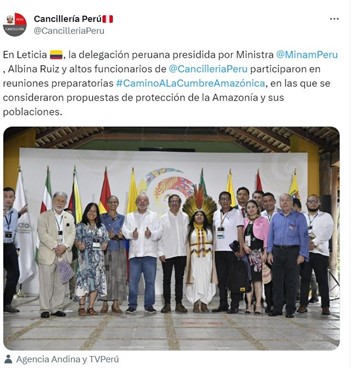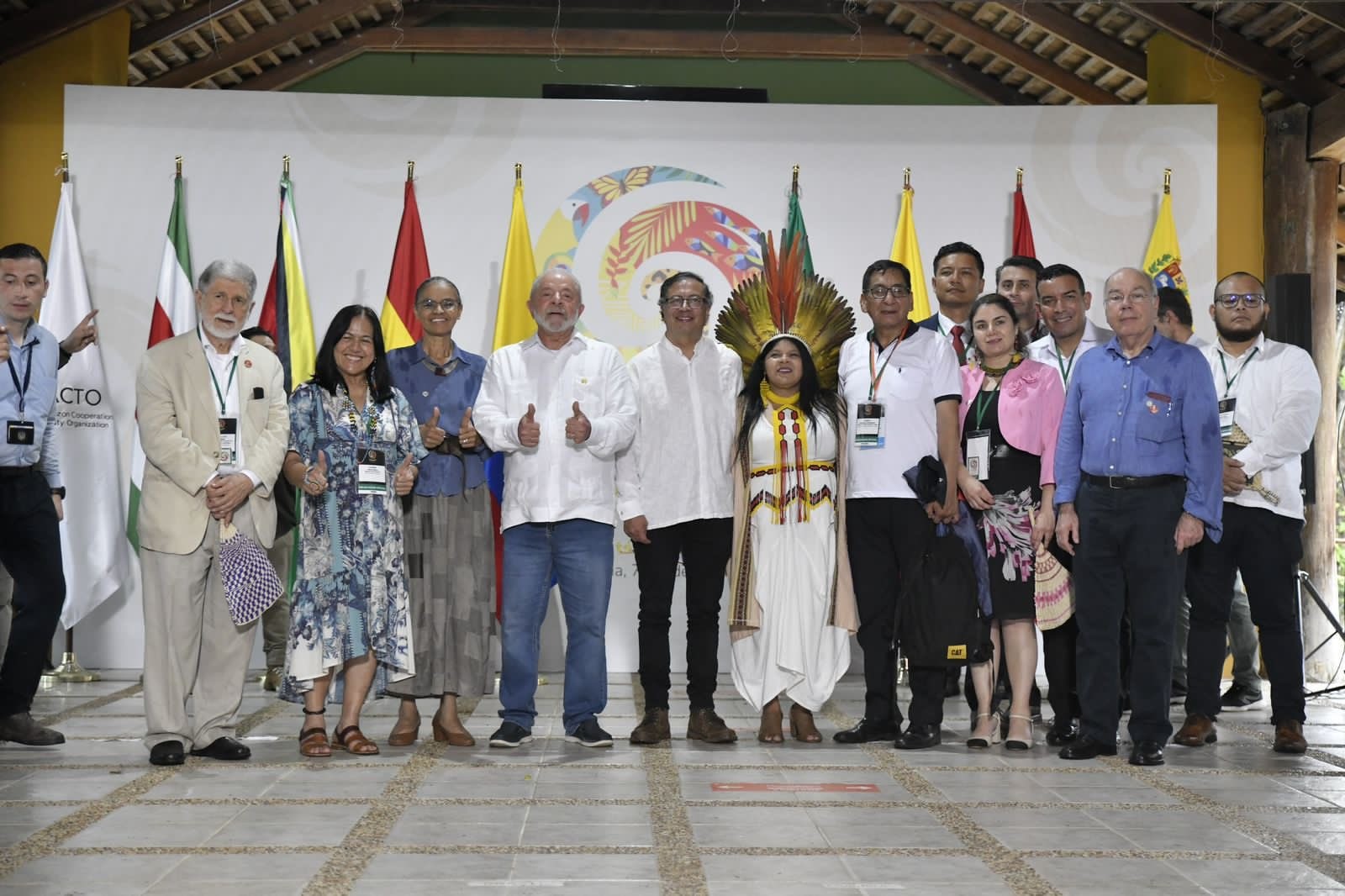Photo: Ministry of Foreign Affairs of Peru
On July 6 and 7, the «Road to the Summit» technical-scientific meetings were held in Leticia, Colombia, convened by Brazil and Colombia, in preparation for the next Summit of Presidents of the Amazon to be held on August 8 and 9 in Belém do Pará, Brazil.
The objective of these meetings was to articulate regional cooperation to define the actions needed to protect and conserve the future of the Amazon; as well as to build a new regional action agenda based on science and ancestral knowledge, addressing issues such as biodiversity, bioeconomy and sustainable cities, governance of indigenous peoples, environmental crimes and deforestation, among others, as detailed in the official program of the event. The Ministers of the Environment also discussed a first draft of a political declaration on the future of the Amazon, which will be consolidated at the next summit in Brazil.
Priorities of the Peruvian Government and articulation spaces
In this fourth summit of the signatory countries of the Amazon Cooperation Treaty Organization (ACTO), Peru, according to the declarations of the Minister of Foreign Affairs, Ana Cecilia Gervasi, sought to propose a vision of the «Amazon with a human face», considering indigenous peoples as a central part of this initiative for the «integral and inclusive development of the Amazon». As part of the Peruvian delegation, the Minister of Environment, Albina Ruiz, participated along with senior officials of the Ministry of Foreign Affairs, as stated in their official Twitter account.

The minister, during one of her speeches, mentioned that the problems that occur in the Amazon are usually caused by areas that are not legally titled or sanitized and, therefore, it requires more effort to recognize them in the territorial plans. He also emphasized the need to conserve forests through productive initiatives and sustainable services, such as ecotourism [1].
Regarding the participation of the Peruvian government, prior to the technical-scientific meetings, DAR consulted the Foreign Ministry on May 31 regarding the Peruvian government’s agenda and position Peru will adopt for this event and for the next Summit of Amazonian Presidents. In this regard, on July 7 they responded:
«(…) Peru is interested in addressing a substantive agenda, which highlights the vision of an «Amazon with a human face», including the consideration of the pluricultural and multi-ethnic condition of the region, the rights and obligations of the native populations, their participation in the sustainable management of Amazonian resources, the promotion of measures to boost bio-businesses, as well as the building of capacities to decisively confront environmental illicit activities.» (INFORMATION REQUESTED IN SAIP N° 427-2023) [2]
However, civil society does not have information nor has it participated in the construction of the country strategy, since the Ministry of Foreign Affairs and the Ministry of the Environment did not convene a space for dialogue nor did it make official information available in a timely manner, especially to indigenous organizations. This is contradictory to the objective of the summit, which seeks to solve the pending problems of the Amazon in a participatory and articulated manner.
Therefore, with a view to the next Summit of Amazonian Presidents in August, there is still time to generate spaces for discussion and, from the government, it is essential to ensure the necessary conditions for the effective participation of civil society, as part of a new social pact for the Amazon.
Urgent issues for the Presidents’ Summit in August:
In that sense, it is crucial to include in the discussions of this space issues relevant to the region(1) the need to promote the development of a energy transition and sustainable, through the formulation and implementation of energy policies in the Amazon that respect human rights and are developed with high environmental standards, helping to reduce dependence on fossil fuels.
(2) Multilateral banks and States are currently promoting actions within the framework of the bioeconomy. bioeconomy in the Amazon, through the use of natural resources, such as forestry. However, this represents opportunities and risks that must be discussed in multi-stakeholder spaces (indigenous peoples, academia, state, companies, among others), in order to build an integrated bioeconomy proposal that is coherent with the indigenous economy.
(3) It is necessary to include the connectivity of the Amazon region in the agenda so that the need to include socio-environmental management tools for the transportation sector is put on the table. It should be remembered that poorly planned roads increase the risk of deforestation and illegal activities.
(4) Today, the International Financial International Financial Institutions (IFIs), are strategic actors, since they influence decision making and there are financial mechanisms in the most strategic sectors of the region, such as transportation, energy, basic services, among others. Therefore, they have a duty to monitor the projects they are part of and must ensure compliance with their safeguards.
(5) It is essential to ensure the protection of human rights defenders and environmental and indigenous defenders defenders, and to promote the Escazú Agreement in Peru.
(6) In addition, it is necessary to information on the progress on the progress of the summit agreements by the governments of each State to civil society is necessary for adequate decision making.
What topics were discussed at the last technical-scientific meetings in Leticia?
In the plenary session «Common challenges of the Amazon countries», the environment ministers of the 8 countries that make up the Amazon biome, considered that, among the main actions, a strategic plan should be defined and a unified vision for the future of the Amazon should be consolidated, in consultation with indigenous peoples to encourage their participation; as well as to promote financial mechanisms and ensure that international cooperation responds to the objectives set. [3].
In addition, it will seek to strengthen technical and research knowledge, uniting academic actors from the eight countries, with the objective of generating their own knowledge and articulated for the benefit of conservation. The working groups and plenary sessions discussed the needs of indigenous peoples and local communities with a view to the sustainability of the Amazonian ecosystem [4], however, in general terms, the peasant, Afro and Quilombola communities were the most absent voices.
The President of Colombia, Gustavo Petro, and the President of Brazil, Luiz Inacio Lula Da Silva, met on July 8 to close the event. They agreed that biodiversity must be protected and the fight against deforestation must be articulated to achieve the conservation and protection of the Amazon. The leaders also called on richer countries to contribute funds for preservation, as the Amazon is a crucial ecosystem for climate change mitigation in the world [5].


